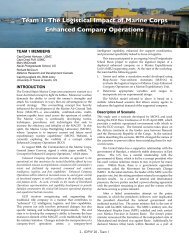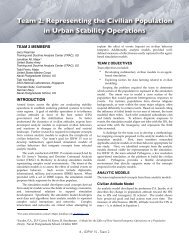pdf file - SEED Center for Data Farming - Naval Postgraduate School
pdf file - SEED Center for Data Farming - Naval Postgraduate School
pdf file - SEED Center for Data Farming - Naval Postgraduate School
You also want an ePaper? Increase the reach of your titles
YUMPU automatically turns print PDFs into web optimized ePapers that Google loves.
Model Validation<br />
The team members were drawn to Team 7 by an<br />
intense interest in the use of data farming as a tool in<br />
model validation. On the one hand, Mr. Blais, Mr.<br />
Stork, and Mr. Upton are members of an NPS team that<br />
have been funded by the Army Geospatial <strong>Center</strong> to<br />
per<strong>for</strong>m various validation studies on the BBE tool to<br />
develop evidence that can be used by accreditation<br />
authorities to determine if the tool is fit <strong>for</strong> its intended<br />
purpose. Mr. Eaton, Mr. Hoffman, and Mr. Rollins<br />
came from a background of common work on<br />
validation of models <strong>for</strong> the USMC Logistics<br />
Command (LOGCOM). Discussions in early working<br />
sessions of the team dealt with the concept and<br />
practice of model validation (in some cases, in contrast<br />
to the concept and practice of model verification). In<br />
[4], Dr. Petty describes two principal comparisons as<br />
the focus of validation activities: (1) comparison of the<br />
real world to the conceptual model; and (2)<br />
comparison of results from the executable model to the<br />
real world. This description is refined in [5] to (1)<br />
comparison of the referent(s) (i.e., what is known about<br />
the real world relative to the intended use of the<br />
model) to the conceptual model; and (2) comparison of<br />
the results from the executable model to the referent(s).<br />
In light of these considerations, the team wanted to<br />
generate evidence that would support a decision that<br />
the model is (or is not) useful <strong>for</strong> its intended purpose<br />
through the following actions:<br />
• Investigate computational behavior<br />
(sensitivities) of the model <strong>for</strong> expected and<br />
anomalous outcomes<br />
• Confirm expectations of the BBE conceptual<br />
model<br />
• Provide a “conversation-starter” between the<br />
software developer and the validation team to<br />
advance common understanding of the intended<br />
model behavior.<br />
Our purpose was definitely not to conduct<br />
verification studies with the model; that is, we were not<br />
investigating the correctness of the implementation of<br />
the software logic with respect to the conceptual model.<br />
On the other hand, it was recognized that any<br />
“disconnect” found by data farming, in light of<br />
expectations raised by knowledge of the conceptual<br />
model <strong>for</strong> the tool, either could be indicative of an issue<br />
in the implementation itself (a possible verification<br />
finding) or indicative of an issue in the conceptual<br />
model (a possible validation finding). In either case, the<br />
objective of the study with respect to model validation was<br />
not to judge whether the outcomes were right or wrong<br />
(against some criteria), or good or bad (based on some<br />
valuation), but to produce evidence that could be used by<br />
others in position to make such assessments with respect to<br />
the intended use of the tool.<br />
<strong>Data</strong> <strong>Farming</strong> Approach<br />
All but one of the members of Team 7 were “IDFW Rookies;”<br />
the one exception being Steve Upton from the NPS <strong>SEED</strong><br />
Figure 3. Terrain Analysis Mobility Network<br />
Figure 4. Wargaming FCOAs against ECOAs in BBE<br />
Figure 5. Friendly COA Evaluation Scores in BBE<br />
<strong>Center</strong>. This meant that the team was particularly motivated<br />
to internalize the guidance and best practices of data farming<br />
as described in one of the plenary sessions and<br />
demonstrated throughout the working sessions by Steve.<br />
Perhaps the following summary will be useful to readers of<br />
this article, and potential attendees of future IDFWs:<br />
• Determine an initial set of factors to explore. Because<br />
the foundation of the BBE processing logic is the<br />
underlying representation of important features of the<br />
terrain (maneuver network), we decided to begin by<br />
examining the sensitivities of model outcomes to<br />
25 - IDFW 20 - Team 7




